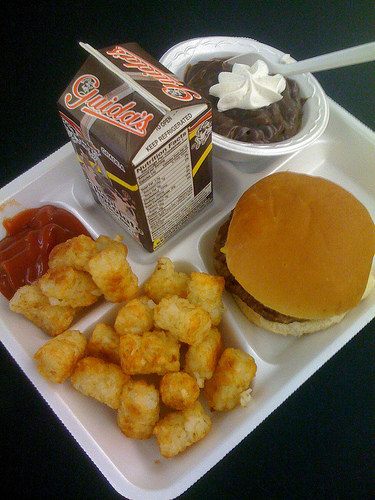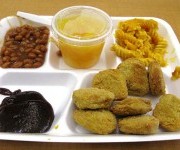 No more lunches like these for Portland kids.Photo courtesy Ben + Sam via FlickrIt all started with a simple idea: to see if school children will actually eat fresh foods, rather than the institutional fare that school kitchens typically serve. To test the idea, the “Farm to School” project of the non-profit Ecotrust partnered up with Portland’s Abernethy Elementary in 2005, embarking on a semester-long trial run of sustainable lunches — beginning with a kitchen renovation and new chef.
No more lunches like these for Portland kids.Photo courtesy Ben + Sam via FlickrIt all started with a simple idea: to see if school children will actually eat fresh foods, rather than the institutional fare that school kitchens typically serve. To test the idea, the “Farm to School” project of the non-profit Ecotrust partnered up with Portland’s Abernethy Elementary in 2005, embarking on a semester-long trial run of sustainable lunches — beginning with a kitchen renovation and new chef.
This was a place where school lunches mattered: 43 percent of students in Portland are eligible for subsidized meals, so school lunches can have a big impact on a student’s daily nutrition.
With Ecotrust’s help, Abernathy Elementary dished up a comprehensive food program, including a school garden, classroom lesson plans around a vegetable of the month, and lunches made with predominately local foods. The food was all cooked on-site, from scratch, with no trans fats allowed. Not only were kids eating significantly higher amounts of produce than their counterparts in other area schools, but the average lunch actually cost $.05 less than the frozen fare typically offered.
But while the food cost less, the labor cost more: the kitchen needed two chefs instead one. That’s one of the first lessons of healthy school lunches: it can be the cost of labor, not of food itself, that squeezes local farmers out of the school lunchroom. Seeing this problem, Ecotrust applied for a grant from the Kaiser Permanente Community Fund, which secured a subsidy of just 7 cents per lunch for schools in the Portland and Gervais school districts in 2009. The subsidy worked, allowing food service directors to buy locally produced food. Not only did students love what they ate, but each dollar spent in Oregon created 84 cents in state economic activity. Not too shabby in a recession.
Since 2007, Oregon has secured farm-to-school coordinators in both the Education and Agriculture departments, an unprecedented action in the United States. In 2009, there was a push to pass House Bill 2800, dubbed “Oregon Farmers Feeding Oregon Kids,” which was endorsed by 80 Oregon organizations. While this bill failed at the last minute, ostensibly due to pressures of the recession, the support it garnered was still promising. Portland food service workers are now challenged with finding ways to cut costs and still buy local, but most are pushing forward with locally sourced menus.
So what’s on the menu? Meals of couscous, burritos from scratch, fresh lasagna and garbanzo/tomato salad make up the mostly vegetarian bill of fare. With less meat on offer, the district can buy higher quality meat when needed. And against common assumptions, kids seem to be giving the new food a thumbs up (but seriously, in a city where a majority of students “already knew what couscous was,” these results might not transfer to a city where kids are less food-conscious).
School districts that want to create the biggest impact on students’ diets can support comprehensive food programs that teach kids about food while dishing up quality meals for lunch. Who can blame a child for turning down a parsnip dish when they have no idea what a parsnip is? Effective school food programs, like Alice Waters’ edible schoolyard program in Berkeley, CA and Auburn, WA’s Farm-to-School program, include garden education along with healthy meals. It’s all in the name of creating a personal connection to what’s on your plate. Washington’s Vashon High School found that students were much more likely to eat mixed veggie dishes if they participated in the school horticulture program. Groups like Growing Gardens in Portland are partnering with schools to make this a reality, a promising start that needs some financial support.
Who knows? The most delicious food in Portland might be in its school cafeterias.
Editor’s note: Excited about Portland’s school lunch program and live in the Northwest? Sightline can hook up you up with a free trip to the City of Roses if you sign up for our emails or recommend us to your friends!
This post originally appeared at Sightline’s Daily Score blog.


